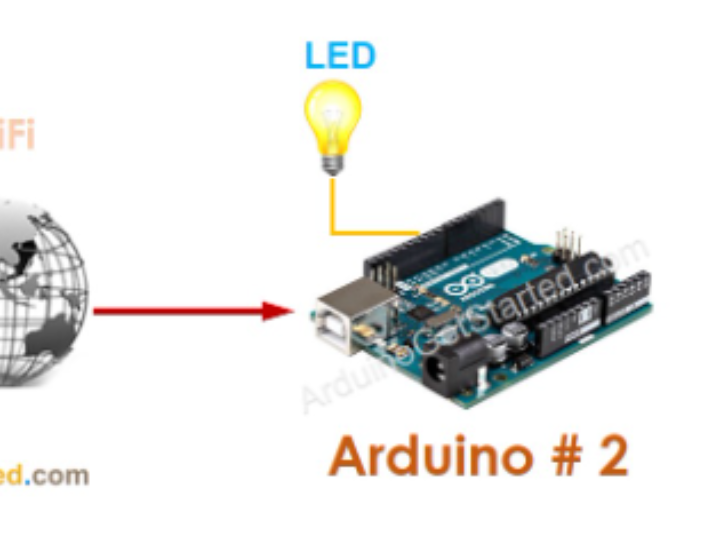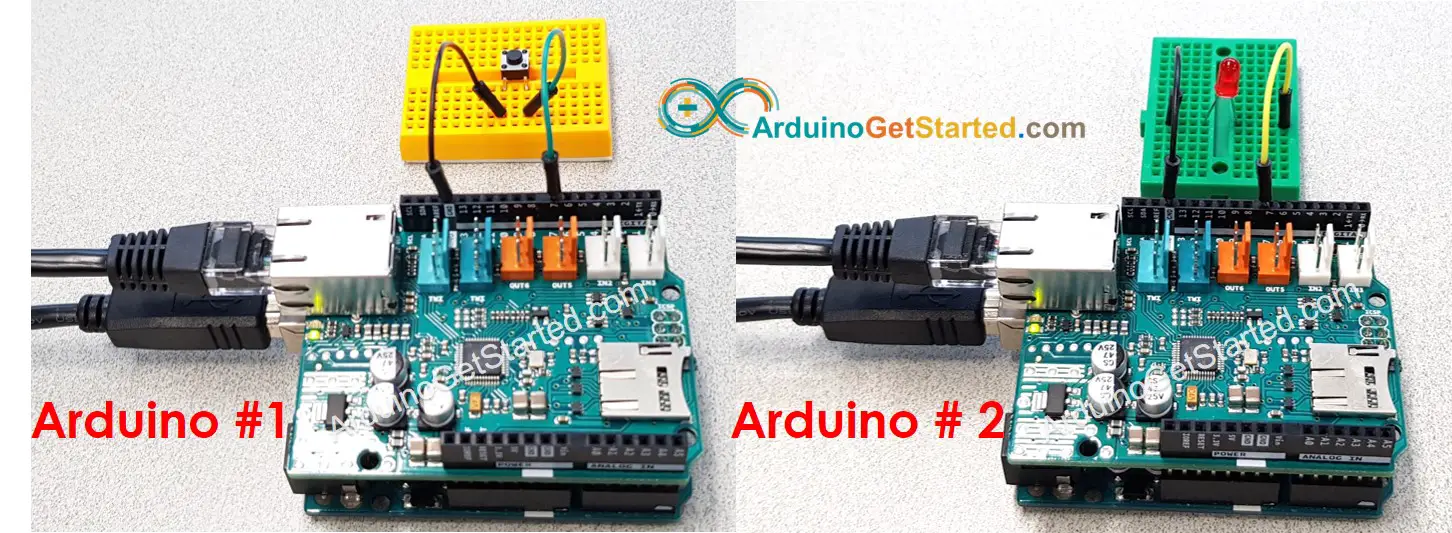Communication between two Arduino
Communication between two Arduino via Ethernet


author defined simple protocol:
TCP connection is created betwwen Arduino #1 and Arduino #2
this is Arduino #1 code
/*
* Created by ArduinoGetStarted.com
*
* This example code is in the public domain
*
* Tutorial page: https://arduinogetstarted.com/tutorials/communication-between-two-arduino
*/
// ARDUINO #1: TCP CLIENT + A BUTTON/SWITCH
#include <ezButton.h>
#include <SPI.h>
#include <Ethernet.h>
const int BUTTON_PIN = 7;
const int serverPort = 4080;
ezButton button(BUTTON_PIN); // create ezButton that attach to pin 7;
byte mac[] = {0x00, 0xAA, 0xBB, 0xCC, 0xDE, 0x03};
IPAddress serverAddress(192, 168, 0, 180);
EthernetClient TCPclient;
void setup() {
Serial.begin(9600);
button.setDebounceTime(50); // set debounce time to 50 milliseconds
Serial.println("ARDUINO #1: TCP CLIENT + A BUTTON/SWITCH");
// Initialize Ethernet Shield:
if (Ethernet.begin(mac) == 0)
Serial.println("Failed to configure Ethernet using DHCP");
// connect to TCP server (Arduino #2)
if (TCPclient.connect(serverAddress, serverPort))
Serial.println("Connected to TCP server");
else
Serial.println("Failed to connect to TCP server");
}
void loop() {
button.loop(); // MUST call the loop() function first
if (!TCPclient.connected()) {
Serial.println("Connection is disconnected");
TCPclient.stop();
// reconnect to TCP server (Arduino #2)
if (TCPclient.connect(serverAddress, serverPort))
Serial.println("Reconnected to TCP server");
else
Serial.println("Failed to reconnect to TCP server");
}
if (button.isPressed()) {
TCPclient.write('1');
TCPclient.flush();
Serial.println("- The button is pressed, sent command: 1");
}
if (button.isReleased()) {
TCPclient.write('0');
TCPclient.flush();
Serial.println("- The button is released, sent command: 0");
}
}
and this is Arduino #2 code
/*
* Created by ArduinoGetStarted.com
*
* This example code is in the public domain
*
* Tutorial page: https://arduinogetstarted.com/tutorials/communication-between-two-arduino
*/
// ARDUINO #2: TCP SERVER + AN LED
#include <SPI.h>
#include <Ethernet.h>
const int LED_PIN = 7;
const int serverPort = 4080;
byte mac[] = {0x00, 0xAA, 0xBB, 0xCC, 0xDE, 0x02};
EthernetServer TCPserver(serverPort);
void setup() {
Serial.begin(9600);
pinMode(LED_PIN, OUTPUT);
Serial.println("ARDUINO #2: TCP SERVER + AN LED");
// Initialize Ethernet Shield:
if (Ethernet.begin(mac) == 0)
Serial.println("Failed to configure Ethernet using DHCP");
// Print your local IP address:
Serial.print("TCP Server IP address: ");
Serial.println(Ethernet.localIP());
Serial.println("-> Please update the serverAddress in Arduino #1 code");
// Listening for a TCP client (from Arduino #1)
TCPserver.begin();
}
void loop() {
// Wait for a TCP client from Arduino #1:
EthernetClient client = TCPserver.available();
if (client) {
// Read the command from the TCP client:
char command = client.read();
Serial.print("- Received command: ");
Serial.println(command);
if (command == '1')
digitalWrite(LED_PIN, HIGH); // Turn LED on
else if (command == '0')
digitalWrite(LED_PIN, LOW); // Turn LED off
Ethernet.maintain();
}
}

